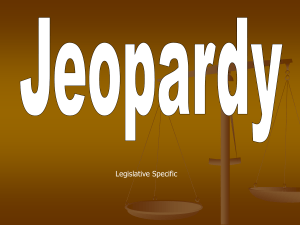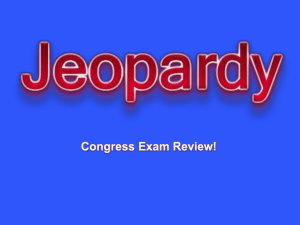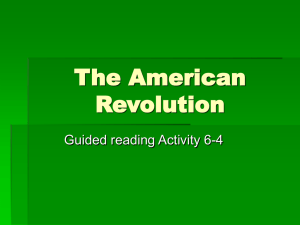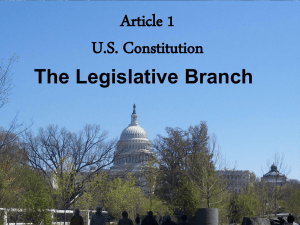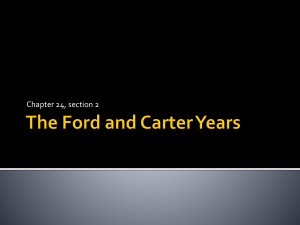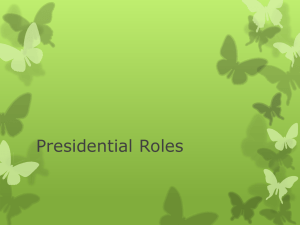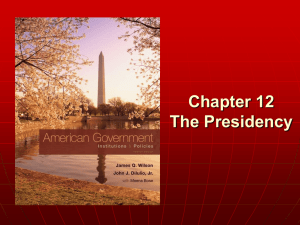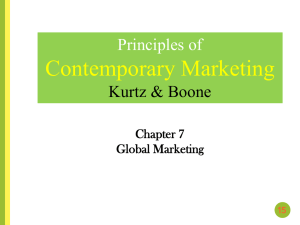Chapter 11 Notes
advertisement
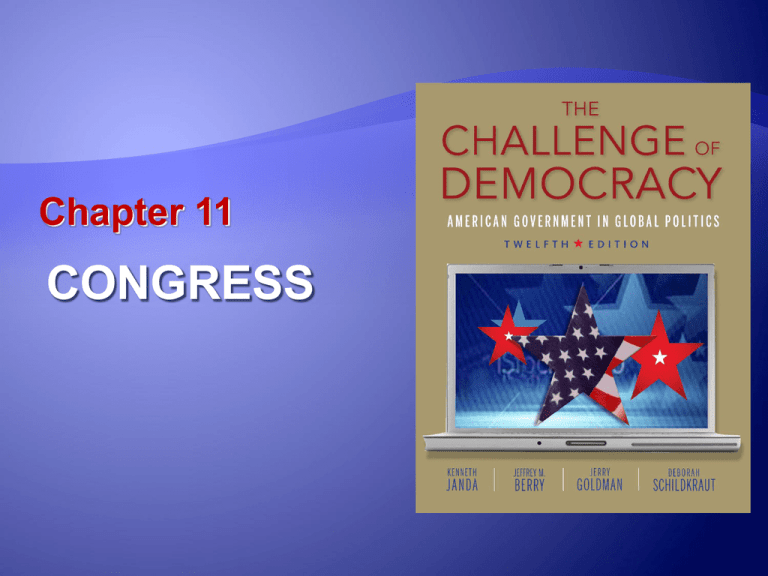
Chapter 11 CONGRESS Learning Outcomes 11.1 Explain the structure and powers of Congress as envisioned by the framers and enumerated in the Constitution. 11.2 Analyze the factors that affect the way voters elect members of Congress 11.3 Describe the ways in which issues get on the congressional agenda. Copyright 2014 Cengage Learning 2 Learning Outcomes 11.4 Differentiate among the types of congressional committees and evaluate the role of the committee system in the legislative process. 11.5 Identify the leadership structure of the legislative branch and assess the rules and norms that influence congressional operations. Copyright 2014 Cengage Learning 3 Learning Outcomes 11.6 Appraise the components of the legislative environment that affect decision making in Congress. 11.7 Consider whether members of Congress should vote according to the majority views of their constituents. 11.8 Assess the elements that characterize Congress as a pluralist or majoritarian system. Copyright 2014 Cengage Learning 4 The Origin and Powers of Congress The Great Compromise Created two separate legislative chambers Equal representation in Senate Proportional representation in House Copyright 2014 Cengage Learning 5 The Origin and Powers of Congress Duties of the House and Senate Declare war Raise an army and navy Borrow and coin money Regulate interstate commerce Create federal courts Establish rules for naturalization of immigrants “Make all Laws which shall be necessary and proper for carrying into Execution and foregoing Powers.” Copyright 2014 Cengage Learning 6 The Origin and Powers of Congress Duties of the House and Senate House of Representatives Originate revenue bills Power of impeachment Senate Try impeachments Approve presidential appointments, treaties with foreign nations and cabinet posts Copyright 2014 Cengage Learning 7 Electing Congress The Incumbency Effect Frequent elections give voters chance to express approval/disapproval with vote Redistricting - Census-based reapportionment Gerrymandering Name recognition Casework Campaign financing Successful challenges Copyright 2014 Cengage Learning 8 Figure 11.1 Incumbents: Life is Good Copyright 2014 Cengage Learning 9 Figure 11.2 We Love Our Incumbents, but Congress Itself Stinks Copyright 2014 Cengage Learning 10 Electing Congress Whom Do We Elect? Elected: not cross-section of American society Most are upper-class professionals Around 47% are millionaires Women and minorities underrepresented Descriptive representation Racial gerrymandering Copyright 2014 Cengage Learning 11 The Millionaires’ Club Copyright 2014 Cengage Learning 12 Figure 11.3 Minorities in Congress Copyright 2014 Cengage Learning 13 How Issues Get on the Congressional Agenda Formal Legislative Process Starts with Introducing bill in House/Senate New issues reach agenda in many ways Highly visible event focuses national attention on problem Presidential support may move an issue quickly Interest group efforts To enhance the image of a legislator Copyright 2014 Cengage Learning 14 The Legislative Process 15 The Lawmaking Process and the Importance of Committees Committees: The Workhorses of Congress Standing committees Subcommittees Joint committees Select committees Conference committees Copyright 2014 Cengage Learning 16 The Lawmaking Process and the Importance of Committees Congressional Expertise and Seniority Seniority Influence increases with seniority and expertise Committee leadership and organization is significant Public policy decision making takes place there Markup sessions Committee members work formally and informally to reach consensus Copyright 2014 Cengage Learning 17 The Show Must Go On Copyright 2014 Cengage Learning 18 The Lawmaking Process and the Importance of Committees Oversight: Following Through on Legislation Congress engages in oversight as extension of efforts to control public policy Oversight performed in different ways Hearing Reports Copyright 2014 Cengage Learning 19 The Lawmaking Process and the Importance of Committees Majoritarian and Pluralist Views of Committees Committee system enhances pluralism Majoritarian aspect as well Committees reflect ideological profiles of the two parties’ congressional contingent In formulating legislation , committees anticipate what other legislators and senators will accept Party loyalty rewarded through committee assignments Copyright 2014 Cengage Learning 20 Leaders and Followers in Congress The Leadership Task Majority party leadership Speaker of the House Majority leader Majority whip Minority party leadership: Minority leader Minority whip Copyright 2014 Cengage Learning 21 The Johnson Treatment Copyright 2014 Cengage Learning 22 The Leadership Task in the Senate Rules of Procedure Rules in chamber based on parliamentary procedure Important Difference between two chambers House Rules Committee governs floor debate Senate Relies on unanimous consent agreements to set start and length of debate Filibuster and cloture Copyright 2014 Cengage Learning 23 The Legislative Environment Political Parties Parties are strong forces in legislative process Most significant reason parties are important Different ideologies Diversity exists but becoming more homogeneous Bargaining: Important norm in Congress Parties have become more polarized, compromise difficult Inability to compromise is a threat to majoritarianism Copyright 2014 Cengage Learning 24 Figure 11.5 Rising Partisanship Copyright 2014 Cengage Learning 25 The Legislative Environment The President Capitalize on popular election and speak for majority Chief legislator White House involved in writing and development of bills Congress allows president a leadership role in proposing legislation but jealously guards power of Congress Congress often clashes sharply with president Copyright 2014 Cengage Learning 26 The Legislative Environment Constituents People in legislator’s district or state are a crucial part of decision-making process Legislators must consider Voters interests Degree to which they should follow constituency preferences Constituents’ influence contributes to pluralism Geographical basis of representation in Congress Push and pull Congress in different directions Copyright 2014 Cengage Learning 27 Constituents Strike Back Copyright 2014 Cengage Learning 28 The Legislative Environment Interest Groups One of the four external sources of influence on Congress Constituents influence Congress via interest groups Represent the population’s groupings Vocational Regional Ideological Copyright 2014 Cengage Learning 29 The Dilemma of Representation Presidents and Shopping Bags Members of Congress live in two worlds World of presidents World of constituents Criticized for being out of touch with constituents Copyright 2014 Cengage Learning 30 The Dilemma of Representation Trustees or Delegates? Trustees Vote their conscience, obligated to consider constituent views but not to vote according to views if they think they are misguided Role more likely in larger, national interest issues Delegates Vote represents majority view of constituents Must be prepared to vote against personal preference Copyright 2014 Cengage Learning 31 Pluralism, Majoritarianism, and Democracy Parliamentary Government Government power in hands of majority party Power concentrated in legislature No separation of governmental power Usually one house or have second, weaker chamber Usually do not have a court that invalidates acts Checks on government action are few Copyright 2014 Cengage Learning 32 Pluralism, Majoritarianism, and Democracy Pluralism Versus Majoritarianism in Congress Modern Congress characterized by both pluralism and majoritarianism Growing partisanship in Congress represents a trend toward greater majoritarianism To a degree, voters recognize difference between parties and vote on that basis; increasing majoritarianism will constrain pluralism in Congress Copyright 2014 Cengage Learning 33
